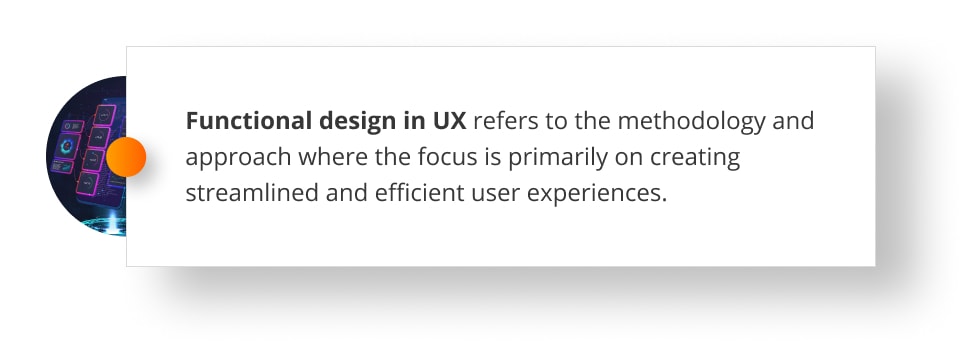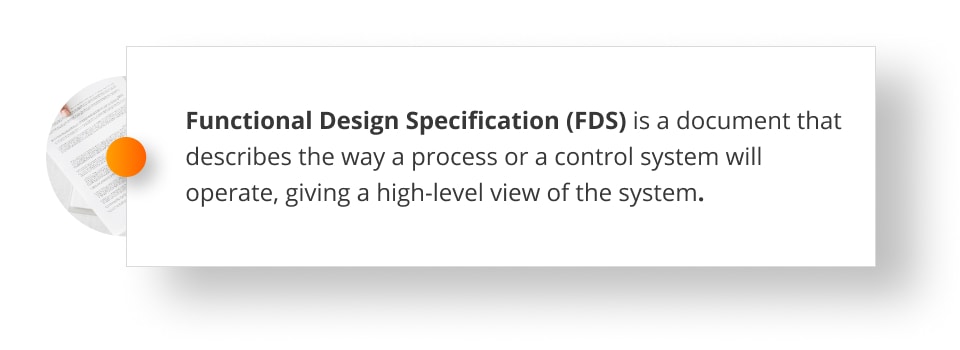
Functional design 101: creating products that people love to use
Creating a beautiful product is one thing. Creating a product that people love to use is another, and we dare say it's much more important. Today we look into the functional design - what is it, what are its key principles, how does it impact your brand perception and credibility.
What is Functional Design Specification (FDS)?
Before we go into more detail, let’s have a look at some basic definitions of functional design and FDS – Functional Design Specification.
Functional design in UX refers to the methodology and approach where the focus is primarily on creating streamlined and efficient user experiences. It involves designing interfaces and systems that prioritise usability, ease of navigation, and the fulfillment of users’ specific tasks and goals.
If you are keen to create a product that is functional and popular among its users, you first need to have a good plan. Such a plan should outline the functional requirements and specifications of the product and provide a detailed step-by-step description of each item’s functionality and flow.
As such, it becomes a crucial part of the design and development process.
And this is exactly what Functional Design Specification (FDS) is all about. Simply put, it’s a document that describes the way a process or a control system will operate, giving a high-level view of the system.
Why is the functional specification document the backbone of any successful product?
Such a functional specification document becomes the backbone of a successful product, as it plays a crucial role in ensuring the product is developed, tested and delivered successfully by providing a clear and comprehensive list of requirements to be taken into consideration during a development process. Let’s look at why it is so important.
Firstly, it clearly outlines the functional requirements of the product, ensuring all stakeholders (such as developers, testers, designers, and project managers) have a common understanding of what the product is expected to achieve.
Secondly, it constitutes an important guidance for developers, a kind of a roadmap that helps them understand the desired features, interactions, and behaviours.
Thirdly, it serves as a basis for testing that ensures the products meets all requirements and adheres to the required standards.
What’s more, a functional specifications document helps in reducing ambiguity and misinterpretation of requirements, serves as a communication tool among all team members, and helps identify potential risks early in the software development process, allowing for changes and modifications needed to achieve a final and efficient product.
Functional specifications of design in technology
Functional specifications documents used in a development process may vary, but they all should contain some important components, such as:
- an overview of the system or product that is being developed,
- a list of functional requirements, together with use cases and scenarios,
- a high level and detailed system architecture,
- data specification,
- a description of the user interface elements,
- risks and assumptions that includes any potential threats to the project,
- prototypes, as it is easier to show complicated features on prototypes than using long descriptions,
- a way of identification of potential errors and an error reporting system,
- performance requirements,
- important security considerations.
The key principles of functional design
If you are willing to create a functional product and are keen to prepare functional specification documentation, there are several principles you should take into consideration.
They all constitute best practice of functional design and help you excel when creating a software system.
Here is a short checklist of things worth thinking about:
- clarity and precision when it comes to articulating the functionality of the system or product,
- customer-centred approach, based on the needs and expectations of the end-users,
- scalability and flexibility, allowing products to adapt to changing requirements,
- consistency in the design to create an intuitive experience,
- simplicity of the design that makes the product easier to understand and use,
- reliability of the product and the implementation of mechanisms for error detection and handling,
- security of the product, needed to protect it against threats,
- performance optimisation,
- cost effectiveness of the design,
- feedback, especially with prototypes,
- adherence to established standards which promotes consistency and compatibility.
How functional design boosts usability
One of the most important benefits of functional design is that it boosts usability by ensuring a product or system is designed with the end user in mind and focuses on delivering a seamless and efficient user experience.
It is so because functional design always starts with understanding of the needs, preferences and behaviour of end users, which allows designers to create interfaces and functionalities that align with user expectations.
A well-designed functional system streamlines tasks and processes, allowing users to effectively accomplish their goals. It also promotes consistency in the user interface, which in turn enhances predictability and makes it easier for users to understand and use different parts of the system.
What’s more, functional design allows also for feedback to users about the actions and the system’s responses, which contributes to a more user-friendly experience.
How functional design impacts brand perception and credibility
Functional design has a massive impact on how users perceive our brand and credibility. How is that possible?
A well-executed functional design reflects professionalism and attention to detail; it also communicates that the brand values the user experience.
Consistency in functional design, both in terms of visual elements and user interactions, contributes to a cohesive brand identity. When users encounter a consistent experience across different platforms and devices, it fosters a sense of reliability and professionalism, positively influencing brand perception.
Innovative and modern functional design can position a brand as forward-thinking and up-to-date with current trends and technologies. This in turn helps building trust among users: they feel they can rely on such a product to perform its intended functions seamlessly.
Building a roadmap for functional design in your own projects
If you are ready to build a roadmap for functional design in your own project and are unsure how to go about it or where to start, do not hesitate to get in touch with our team.
At Future Processing we have a vast experience in providing our clients with a great amount of experience design and digital product services – from planning a strategy and creating a functional specification document, to building the actual product and adding to its unique value – and we will be happy to look into your case.
No matter which stage of the process you are at, we would love to help!






